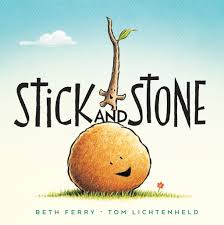 Stick and Stone written by Beth Ferry and illustrated by Tom Lichtenheld is a delightfully unexpected spin on the way we usually think about sticks and stones. Instead of being “weapons,” Stick and Stone are two characters in a sweet but powerful story. Sparse prose brilliantly captures the budding friendship of two solitary loners: Stick and Stone. They discover that everything is better when shared with a friend. Lichtenfeld captures the depth and range of their friendship in simple, bright illustrations that pulse with warmth and coziness. When Stone is bullied by a mean and prickly pinecone, Stick comes to his defense, using his words not his fists. “Because that is what friends do.”
Stick and Stone written by Beth Ferry and illustrated by Tom Lichtenheld is a delightfully unexpected spin on the way we usually think about sticks and stones. Instead of being “weapons,” Stick and Stone are two characters in a sweet but powerful story. Sparse prose brilliantly captures the budding friendship of two solitary loners: Stick and Stone. They discover that everything is better when shared with a friend. Lichtenfeld captures the depth and range of their friendship in simple, bright illustrations that pulse with warmth and coziness. When Stone is bullied by a mean and prickly pinecone, Stick comes to his defense, using his words not his fists. “Because that is what friends do.”
Stick’s intervention on behalf of his friend is a model for the power of one individual to make a difference. (Refer to last week’s blog The Power of One.) Stone is surprised by Stick’s brave gesture. Stick replies that is what friends do. Readers will connect with the moment of friendship in action, of loyalty and courage to speak up. Kids know what it is like to need that buddy. They also understand how challenging it can be to stand up against a bully. This story offers a chance to place themselves in both situations and imagine how they might feel, think and act. Later in the story, Stone has the opportunity to return the favor of friendship when he rescues his friend Stick. Again the refrain “That’s what friends do,” is repeated.
The AQ* Lens: We’ve all heard the adage, “Sticks and stones may break my bones but words will never hurt me.” We all know the fundamental untruth of this saying through direct personal experience. Words have immense power—to heal, to connect, to divide and to destroy. As adoptive parents we know we must prepare our kids to face the dreaded day/s when a rude remark about adoption, birth parents, being given away, etc.
We can use words to empower our kids. Provide them with an arsenal of respectful adoption language. Help them to reframe ignorant remarks as an opportunity to educate other kids, even adults. Unfortunately, sometimes the speaker intends to shame, humiliate, or insult. If that is the case, do not minimize the experience. This would invalidate the reality of their experience and create a relationship disconnect. Instead, talk about why other kids might not understand adoption and how that can create fear and misunderstanding.
It’s never too early to teach kids about personal boundaries—especially around their adoption. Help them to understand the distinction between private and secret. Adoption is not secret. Nonetheless, parts of their story are private—not for general discussion with any/every curious person. They need not feel obligated to divulge personal information just because a question is asked. (This goes for us adults as well. The best way to equip kids with firm boundaries is by our own example. As they observe us when we encounter intrusive, inappropriate questions about their adoption, our children can “study” our respectful, courteous “boundary-establishing” response.

